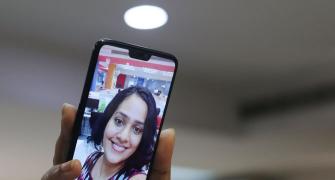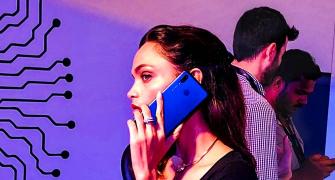Here's what you need to know, says Ashish Narsale.

LG was one of the earliest brands to experiment with its phones. They came up with the LG G Flex, a curved display phone; the LG G5, a modular phone; the LG V20, a phone with dual display, and many more.
Unfortunately, LG smartphones have been highly underrated, even when they were packaged with the latest hardware and features with respect to price.
Also, the price of an LG smartphone drops substantially faster than its competitors.
These factors have impacted LG's strategy in the smartphone business.
The new LG G7+ ThinQ, which follows the LG G6, has the layout most smartphone manufacturers are following nowadays -- the notch design.
ThinQ is the new series from LG; the label denotes that the devices have AI.
Let's see what LG G7+ ThinQ has under its hood.

Design
The LG G7+ comes with a major design overhaul that brings it on par with its competitors.
The front and back of the phone is protected by Corning Gorilla Glass 5.
Its rigidity is maintained by the aluminium frame sandwiched between glass layers, which encompass the vital components.
The phone is certified as IP68, which means it is resistant against dust and water.
Furthermore, it has the MIL-STD-810G military grade certification, which means it is protected against impact if dropped.
The phone measures 6.03” inches tall, 2.83” inches wide and 0.31” inches in thickness.
The camera setup in the rear is placed vertically in the centre of the phone, with the fingerprint scanner just below it.
The laser autofocus and the flash are vertically adjacent to the camera.
In a bold move, the power button, which used to be included within the fingerprint scanner, is now given dedicated space on the left side of the phone.
Just like the Samsung's dedicated Bixby button, the LG G7+ has included a dedicated button placed on the right of the phone to activate Google assistant.
The Google lens can also be activated to identify an object in real-time and search the internet for shopping or finding information about it.
The volume control buttons are placed just above the Google assistant button.
While the LG G7+ follows the notch design, the notch can be hidden using the software settings. LG, however, goes a step further and allows you to select a theme from varying colour options for the area surrounding the notch.
Display
Due to the notch design, the phone has what LG calls a FullVision display, with an aspect ratio of 19.5:9.
The display measures 6.1” inches, with a resolution of 3120 x 1440 QHD+ display.
It supports Always-On Display, which shows notifications and the date and time when the phone is on standby mode.

Camera
LG has always included top of the line cameras in its flagship phones.
On the rear, there are two 16 MP cameras.
The primary camera is a standard angle with a 71 degrees field of view. It has a wider aperture of f/1.6 to take in more light, which is essential in low light conditions.
Other than laser autofocus, the primary camera is supported by Optical Image Stabiliser and Electronic Image Stabiliser for improving low light photography and to ensure steady video recording.
The secondary camera is built for wide angle photos and depth sensing while taking a portrait photo with the background blurred. It has a wide angle with 107 degrees field of view and has a narrower aperture f/1.9 when compared to the primary camera.
The cameras are equipped with AI for scene detection and optimising the camera settings to take better photos based on the environment, lighting conditions and subject. They also support pro mode and save images as RAW files.
The RAW image file is the original uncompressed version of the image which is otherwise automatically compressed and processed by the camera software. As a result, these images are more detailed and one can use photo editing software to edit it to one's liking.
The camera supports up to 4K video recording at 30 fps. It also supports HDR10 (High Dynamic Ratio) video recording with a wider spectrum of colour and greater contrast ratio between light and dark areas.
The LG G7+ has an added advantage over conventional video recording as it provides 15 cine effects and a colour grading process to give your video a cinematic look.
The camera can even shoot slow motion video with HD resolution at 240 fps.
The front camera is upgraded from the 5 MP of its predecessor to 8 MP with f/1.9.
Hardware
The phone comes with flagship hardware and is powered by the latest Qualcomm's Snapdragon 845 with Octa-core CPU, clocked at 2.8 GHz x 4 + 1.7 GHz x 4 and embedded GPU Adreno 630 for graphics and multimedia.
The Snapdragon 845 is partnered with 6 GB of RAM and 128 GB of ROM as onboard storage.
If you still fall short, storage can be expanded up to 2 TB using a memory card but you need to sacrifice the extra SIM space on the hybrid SIM slot.
The heat generated by the processor is taken care by Heat Pipe technology, which absorbs and disperses the heat all over the body in order to reduce the heat.
Audio
When it comes to sound, the phone has a mono speaker but promises a loud sound.
A space designed in the phone acts as a resonance chamber to give loud sound output.
For audio enhancement over wired headphones, the phone is embedded with 32-Bit Hi-Fi Quad DAC (Digital-to-Analog Converter) and DTS-X Virtual Surround Sound.
Security
For security, other than the usual fingerprint scanner, the phone also supports face and voice recognition and LG's own Knock-Code unlock system.
Battery
The phone has a 3000 mAh inbuilt battery, which seems inadequate considering today's requirements, but supports Qualcomm Quick charge 3.0.
It also supports wireless charging.
The wired charging and data transfer can be done through the latest USB Type-C port.
Software
The phone comes with Android Oreo 8.0 out of the box with LG UX 7.0 overlaid.
Verdict
If we compare the LG G7+ and the OnePlus 6, the LG G7+ packs in more premium flagship features such as IP68 rating, support for memory card expansion, wireless charging and QHD+ display at almost the same price.
LG G7+, with 6 GB RAM and 128 ROM, is priced at ₹39,990 and the OnePlus 6 with 8 GB RAM and 128 GB ROM costs ₹39,999.
Whether it performs better than the OnePlus 6 remains to be seen.










